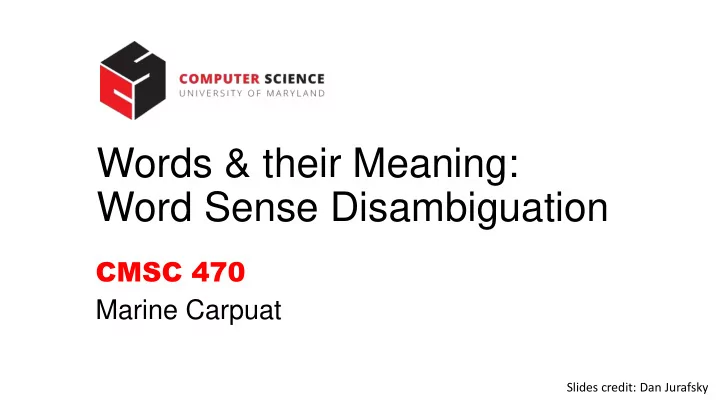

Words & their Meaning: Word Sense Disambiguation CMSC 470 Marine Carpuat Slides credit: Dan Jurafsky
Today: Word Meaning 2 core issues from an NLP perspective • Semantic similarity : given two words, how similar are they in meaning? • Word sense disambiguation : given a word that has more than one meaning, which one is used in a specific context?
“ Big rig carrying fruit crashes on 210 Freeway, creates jam ” http://articles.latimes.com/2013/may/20/local/la-me-ln-big-rig-crash-20130520
How do we know that a word (lemma) has distinct senses? • Linguists often design tests for Which flight serves breakfast? this purpose Which flights serve BWI? • e.g., zeugma combines distinct senses in an uncomfortable way *Which flights serve breakfast and BWI?
Word Senses • “Word sense” = distinct meaning of a word • Same word, different senses • Homonyms (homonymy): unrelated senses; identical orthographic form is coincidental • E.g., financial bank vs. river bank • Polysemes (polysemy): related, but distinct senses • E.g., Financial bank vs. blood bank vs. tree bank • Metonyms (metonymy): “stand in”, technically, a sub -case of polysemy • E.g., use “Washington” in place of “the US government” • Different word, same sense • Synonyms (synonymy)
• Homophones: same pronunciation, different orthography, different meaning • Examples: would/wood, to/too/two • Homographs: distinct senses, same orthographic form, different pronunciation • Examples: bass (fish) vs. bass (instrument)
Relationship Between Senses • IS-A relationships • From specific to general (up): hypernym (hypernymy) • From general to specific (down): hyponym (hyponymy) • Part-Whole relationships • wheel is a meronym of car (meronymy) • car is a holonym of wheel (holonymy)
WordNet: a lexical database for English https://wordnet.princeton.edu/ • Includes most English nouns, verbs, adjectives, adverbs • Electronic format makes it amenable to automatic manipulation: used in many NLP applications • “ WordNets ” generically refers to similar resources in other languages
Synonymy in WordNet • WordNet is organized in terms of “ synsets ” • Unordered set of (roughly) synonymous “words” (or multi -word phrases) • Each synset expresses a distinct meaning/concept
WordNet: Example Noun {pipe, tobacco pipe} (a tube with a small bowl at one end; used for smoking tobacco) {pipe, pipage, piping} (a long tube made of metal or plastic that is used to carry water or oil or gas etc.) {pipe, tube} (a hollow cylindrical shape) {pipe} (a tubular wind instrument) {organ pipe, pipe, pipework} (the flues and stops on a pipe organ) Verb {shriek, shrill, pipe up, pipe} (utter a shrill cry) {pipe} (transport by pipeline) “pipe oil, water, and gas into the desert” {pipe} (play on a pipe) “pipe a tune” {pipe} (trim with piping) “pipe the skirt”
WordNet 3.0: Size Part of speech Word form Synsets Noun 117,798 82,115 Verb 11,529 13,767 Adjective 21,479 18,156 Adverb 4,481 3,621 Total 155,287 117,659 http://wordnet.princeton.edu/
Word Sense Disambiguation • Task: automatically select the correct sense of a word • Input: a word in context • Output: sense of the word • Motivated by many applications: • Information retrieval • Machine translation • …
How big is the problem? • Most words in English have only one sense • 62% in Longman’s Dictionary of Contemporary English • 79% in WordNet • But the others tend to have several senses • Average of 3.83 in LDOCE • Average of 2.96 in WordNet • Ambiguous words are more frequently used • In the British National Corpus, 84% of instances have more than one sense • Some senses are more frequent than others
Baseline Performance • Baseline: most frequent sense • Equivalent to “take first sense” in WordNet • Does surprisingly well! 62% accuracy in this case!
Upper Bound Performance • Upper bound • Fine-grained WordNet sense: 75-80% human agreement • Coarser-grained inventories: 90% human agreement possible
Simplest WSD algorithm: Lesk’s Algorithm • Intuition: note word overlap between context and dictionary entries • Unsupervised, but knowledge rich The bank can guarantee deposits will eventually cover future tuition costs because it invests in adjustable-rate mortgage securities. WordNet
Lesk’s Algorithm • Simplest implementation: • Count overlapping content words between glosses and context • Lots of variants: • Include the examples in dictionary definitions • Include hypernyms and hyponyms • Give more weight to larger overlaps (e.g., bigrams) • Give extra weight to infrequent words • …
Alternative: WSD as Superv rvised Classification Training Testing training data unlabeled ? document label 1 label 2 label 3 label 4 Feature Functions label 1 ? label 2 ? supervised machine Classifier learning algorithm label 3 ? label 4 ?
Existing Corpora • Lexical sample • line-hard-serve corpus (4k sense-tagged examples) • interest corpus (2,369 sense-tagged examples) • … • All-words • SemCor (234k words, subset of Brown Corpus) • Senseval/SemEval (2081 tagged content words from 5k total words) • …
Word Meaning 2 core issues from an NLP perspective • Semantic similarity : given two words, how similar are they in meaning? • Key concepts: vector semantics, PPMI and its variants, cosine similarity • Word sense disambiguation : given a word that has more than one meaning, which one is used in a specific context? • Key concepts: word sense, WordNet and sense inventories, unsupervised disambiguation (Lesk), supervised disambiguation
Recommend
More recommend